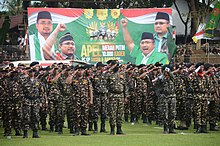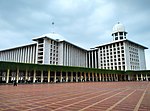Multi-purpose Ansor Front | |
 Insignia of Banser | |
| Abbreviation | Banser |
|---|---|
| Formation | 1937 |
| Type | Paramilitary Organization |
Region served | Indonesia |
Official language | Bahasa Indonesia |
Commander | General Candra |
Parent organization | |
| Affiliations | |
Volunteers | 7.000.000 (2019) |
Multipurpose Ansor Front, better known as Banser (abbreviation of Barisan Ansor Serbaguna), is an Islamic militia organization based in Indonesia. It is a paramilitary wing of the youth organization Ansor Youth Movement (GP Ansor) affiliated with Nahdlatul Ulama (NU), the largest Islamic mass organization in the world. Banser operates as a semi-autonomous body of GP Ansor and mainly serves for the security and humanitarian operations. Combined personnel of Banser doubles the number for the Indonesian National Armed Forces (TNI), making Banser (and its parent organization GP Ansor) a political heavyweight which holds the key to the national stability.[1] Throughout the history, Banser had played major roles especially in issues related to religion, from the active participation in Indonesian mass killings of 1965–1966 against the perceived members of Indonesian Communist Party,[2] to the more recent development of standoff against Hizbut Tahrir Indonesia.[3] In terms of political orientation, Banser, along with GP Ansor, is characterized by traditionalist Islam, populism and nationalism.

